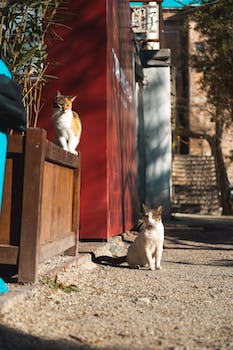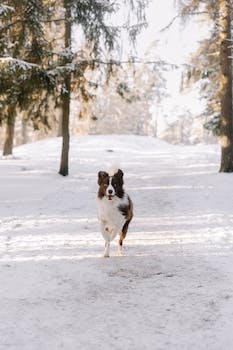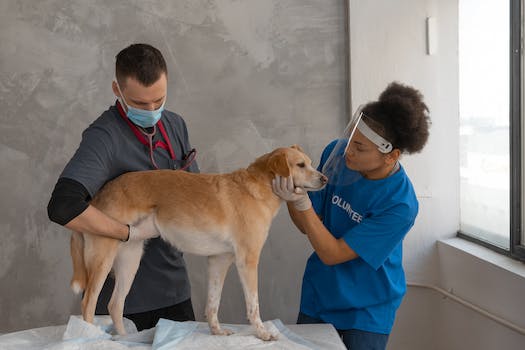

-
Table of Contents
Winter Care: Tips and Tricks to Keep Our Pets Warm - Ensuring Comfort and Safety for Our Furry Friends
Introduction
Winter Care: Tips and Tricks to Keep Our Pets Warm
As the colder months approach, it is important to ensure that our beloved pets are kept warm and comfortable. Just like humans, animals can be susceptible to the cold weather and may require some extra care during the winter season. In this article, we will provide you with essential tips and tricks to help keep your pets warm and safe throughout the winter months. By following these guidelines, you can ensure that your furry friends stay cozy and healthy during this chilly time of year.
How to Choose the Right Winter Clothing for Your Pet
Winter Care: Tips and Tricks to Keep Our Pets Warm
As the temperature drops and the snow starts to fall, it's important to remember that our furry friends need extra care and attention during the winter months. Just like humans, pets can be susceptible to the cold weather and may need some help staying warm and comfortable. One way to ensure their well-being is by choosing the right winter clothing for them.
When it comes to selecting winter clothing for your pet, there are a few factors to consider. First and foremost, you'll want to think about the size and breed of your pet. Smaller dogs and those with short hair are more likely to feel the cold, so they may require extra layers to keep them warm. On the other hand, larger dogs and those with thick fur may not need as much protection from the cold.
Next, you'll want to consider the type of winter clothing that will best suit your pet's needs. There are a variety of options available, including sweaters, coats, and boots. Sweaters are a great choice for indoor pets or those who only need a little extra warmth. They come in a range of styles and materials, so you can find one that fits your pet's personality and keeps them cozy.
For pets who spend a lot of time outdoors, a coat may be a better option. Coats are typically made from waterproof or water-resistant materials, which can help protect your pet from rain, snow, and wind. Look for a coat that covers your pet's back and chest, as these are the areas most vulnerable to the cold. Additionally, coats with reflective strips can help keep your pet visible during those dark winter nights.
If your pet will be walking on icy or snowy surfaces, consider investing in a pair of boots. Boots can help protect your pet's paws from frostbite and injury. Look for boots with rubber soles and adjustable straps, as these will provide the best traction and fit. It may take some time for your pet to get used to wearing boots, so be patient and reward them with treats and praise.
When choosing winter clothing for your pet, it's important to ensure a proper fit. Clothing that is too tight can restrict movement and cause discomfort, while clothing that is too loose may not provide adequate warmth. Take accurate measurements of your pet's neck, chest, and length, and refer to the manufacturer's sizing chart to find the right size. If you're unsure, it's always best to go up a size rather than risk getting something too small.
Lastly, don't forget to consider your pet's individual preferences and needs. Some pets may be more sensitive to the cold than others, so they may require additional layers or thicker materials. Additionally, older pets or those with certain health conditions may need extra warmth and protection. Consult with your veterinarian if you have any concerns or questions about your pet's winter clothing needs.
In conclusion, choosing the right winter clothing for your pet is an important part of keeping them warm and comfortable during the colder months. Consider their size, breed, and individual needs when selecting sweaters, coats, or boots. Ensure a proper fit and be mindful of their preferences and sensitivities. By taking these steps, you can help ensure that your furry friend stays cozy and safe all winter long.
Essential Winter Care Tips for Outdoor Pets

Winter Care: Tips and Tricks to Keep Our Pets Warm
Essential Winter Care Tips for Outdoor Pets
As the temperature drops and the snow begins to fall, it's important to remember that our furry friends need extra care and attention during the winter months. While some pets are lucky enough to spend their days indoors, others, such as outdoor pets, may need a little extra help to stay warm and comfortable. In this section, we will discuss some essential winter care tips for outdoor pets.
First and foremost, it's crucial to provide outdoor pets with proper shelter. A sturdy and insulated doghouse or cat shelter is essential to protect them from the harsh elements. Make sure the shelter is elevated off the ground to prevent moisture from seeping in. Additionally, consider adding a thick layer of straw or blankets inside the shelter to provide extra warmth and insulation. Regularly check the shelter for any leaks or damage, and repair them promptly to ensure your pet's safety.
Another important aspect of winter care for outdoor pets is providing them with adequate food and water. Cold weather can increase their calorie needs, so it's essential to provide them with a well-balanced and nutritious diet. Consult your veterinarian to determine the appropriate amount and type of food for your pet during the winter months. Additionally, ensure that their water supply is not frozen. Consider using heated water bowls or checking their water frequently to prevent dehydration.
Grooming is also crucial for outdoor pets during winter. While it may seem counterintuitive, regular grooming helps to maintain their coat's insulation properties. Brushing your pet's fur helps to remove dead hair and matting, allowing their natural coat to provide better insulation. However, be cautious not to over-bathe your pet during winter, as it can strip their skin of essential oils and make them more susceptible to the cold.
Exercise is vital for pets, even during winter. However, it's important to be mindful of the weather conditions. Avoid taking your pet for walks during extreme cold or snowy weather, as it can be dangerous for both of you. Instead, find alternative ways to keep them active indoors, such as playing fetch or using interactive toys. If you do take them outside, ensure they are wearing appropriate winter gear, such as a coat or booties, to protect them from the cold and ice.
Lastly, pay close attention to your pet's behavior and health during winter. Cold weather can exacerbate certain health conditions, such as arthritis, so it's important to monitor any changes in their mobility or behavior. If you notice any signs of discomfort or illness, consult your veterinarian immediately. Additionally, be cautious of antifreeze and other chemicals commonly used during winter, as they can be toxic to pets. Keep these substances out of reach and clean up any spills promptly.
In conclusion, providing essential winter care for outdoor pets is crucial to ensure their well-being and comfort during the colder months. By providing them with proper shelter, food, water, grooming, exercise, and monitoring their health, we can help our furry friends stay warm and safe. Remember, our pets rely on us to keep them protected, so let's make sure we do everything we can to keep them cozy and happy this winter.
Indoor Winter Care: Creating a Cozy Environment for Your Pet
Winter Care: Tips and Tricks to Keep Our Pets Warm
As the temperature drops and the snow begins to fall, it's important to ensure that our furry friends are kept warm and comfortable during the winter months. While many pets may enjoy playing in the snow, it's crucial to provide them with a cozy indoor environment to retreat to when the weather becomes too harsh. In this section, we will explore some tips and tricks to create a warm and inviting space for our pets during the winter season.
First and foremost, it's essential to provide our pets with a comfortable bed or sleeping area. Just like humans, animals appreciate a warm and soft place to rest. Consider investing in a pet bed that is designed to provide insulation and warmth. Look for beds with thick padding and materials that retain heat, such as fleece or faux fur. Additionally, placing a blanket or a heated pet pad in their bed can provide extra warmth and comfort.
Another important aspect of creating a cozy environment for our pets is to ensure that their living space is well-insulated. Check for any drafts or cold spots in the room where your pet spends most of their time. Seal any gaps or cracks in windows and doors to prevent cold air from seeping in. You can also use weather stripping or draft stoppers to further insulate the area. By keeping the cold air out and the warm air in, you'll be providing a much more comfortable space for your pet.
In addition to insulation, it's crucial to maintain a consistent temperature in your pet's living area. While it may be tempting to turn down the thermostat to save on energy costs, it's important to remember that our pets are more sensitive to the cold than we are. Keep the temperature at a comfortable level, ideally between 68-72 degrees Fahrenheit. If you're concerned about energy consumption, consider using a programmable thermostat that allows you to adjust the temperature based on your pet's schedule.
Furthermore, it's important to keep your pet well-groomed during the winter months. Regular brushing helps to remove dead hair and improve circulation, which in turn helps to keep them warm. However, be cautious not to over-bathe your pet during this time, as excessive bathing can strip their skin of essential oils and cause dryness. If your pet spends a lot of time outdoors, consider investing in a pet-friendly moisturizing shampoo to prevent dry skin and irritation.
Lastly, don't forget about hydration. While it may seem counterintuitive, pets can become dehydrated in the winter just as easily as they can in the summer. Ensure that your pet always has access to fresh water and check their water bowl regularly to make sure it hasn't frozen over. If your pet spends a lot of time outdoors, consider using a heated water bowl to prevent freezing.
In conclusion, creating a cozy environment for our pets during the winter months is essential for their well-being. By providing a comfortable bed, insulating their living space, maintaining a consistent temperature, grooming them appropriately, and ensuring they stay hydrated, we can help keep our furry friends warm and happy throughout the winter season. Remember, our pets rely on us to keep them safe and comfortable, so let's make sure we do our best to provide them with the care they deserve.
Q&A
1. How can I keep my pet warm during winter?
Provide your pet with a warm and insulated shelter, use pet-safe heating pads or blankets, dress them in appropriate winter clothing, and limit their time outdoors in extreme cold weather.
2. Are there any specific winter hazards I should be aware of for my pet?
Yes, be cautious of antifreeze poisoning, frostbite, and hypothermia. Keep antifreeze out of reach, wipe your pet's paws after walks to remove any ice-melting chemicals, and watch for signs of cold-related health issues.
3. What are some signs that my pet may be suffering from the cold?
Signs of cold-related distress in pets include shivering, lethargy, difficulty walking, pale or discolored skin, and excessive licking or biting of paws. If you notice any of these signs, seek veterinary care immediately.
Conclusion
In conclusion, providing proper winter care for our pets is essential to keep them warm and safe during the colder months. Some important tips and tricks include providing adequate shelter, using appropriate clothing or accessories, adjusting their diet, and being mindful of their exercise routine. By following these guidelines, we can ensure that our furry friends stay comfortable and healthy throughout the winter season.












